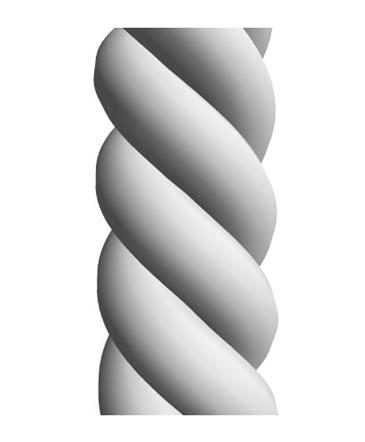Mathematics Reveal Universal Properties Of Old Rope
Ropes are generally useful things to have around, not least because the best of them tend not to stretch under tension.

The ancient Egyptians can attest to that and thoughtfully left pictures on the inside of various tombs showing how they made their ropes. It turns out they do it in a way that it essentially identical to way we do it today, with the strands under tension as they are wound.
Despite rope’s obvious geometric properties, the art of rope making has been strangely neglected by mathematicians over the centuries. Today, Jakob Bohr and Kasper Olsen at the Technical University of Denmark put that right by proving the remarkable property that ropes cannot have more than a certain number of turns per unit length, a number which depends on the diameter of the component strands.
And that’s just the start. They go on to show that a rope with a smaller number turns than this maximum will always twist in one direction or another under tension. So they call this maximum number of turns the zero-twist configuration.
Perhaps more remarkably, they also prove that strands in a zero twist configuration will always be laid at a specific pitch angle. This leads to a proof that up a rope in a zero-twist configuration will always be a specific proportion of the length of its component strands.
Let’s take the example of a three strand rope. To achieve the zero twist configuration, the strands have to be laid down at an angle of 42.5 degrees relative to the horizontal in the image above. This always produces a rope that is 68 per cent the length of the strands.
The work also explains why ropes are best made with the strands under tension. The force causes the pitch angle to be less than ideal so that when the force is relaxed the rope ‘relaxes’ into the zero twist configuration, which cannot be further stretched under tension.
How these properties of ropes have escaped attention is a mystery, given they’ve been around for so long.
But most amazing of all is that these properties of rope depend only on its geometry, not its material properties. Which also explains why ropes made of all kinds of different materials look and behave in remarkably similar ways.
Ref: arxiv.org/abs/1004.0814: The Ancient Art Of Laying Rope
Keep Reading
Most Popular
Large language models can do jaw-dropping things. But nobody knows exactly why.
And that's a problem. Figuring it out is one of the biggest scientific puzzles of our time and a crucial step towards controlling more powerful future models.
The problem with plug-in hybrids? Their drivers.
Plug-in hybrids are often sold as a transition to EVs, but new data from Europe shows we’re still underestimating the emissions they produce.
Google DeepMind’s new generative model makes Super Mario–like games from scratch
Genie learns how to control games by watching hours and hours of video. It could help train next-gen robots too.
How scientists traced a mysterious covid case back to six toilets
When wastewater surveillance turns into a hunt for a single infected individual, the ethics get tricky.
Stay connected
Get the latest updates from
MIT Technology Review
Discover special offers, top stories, upcoming events, and more.